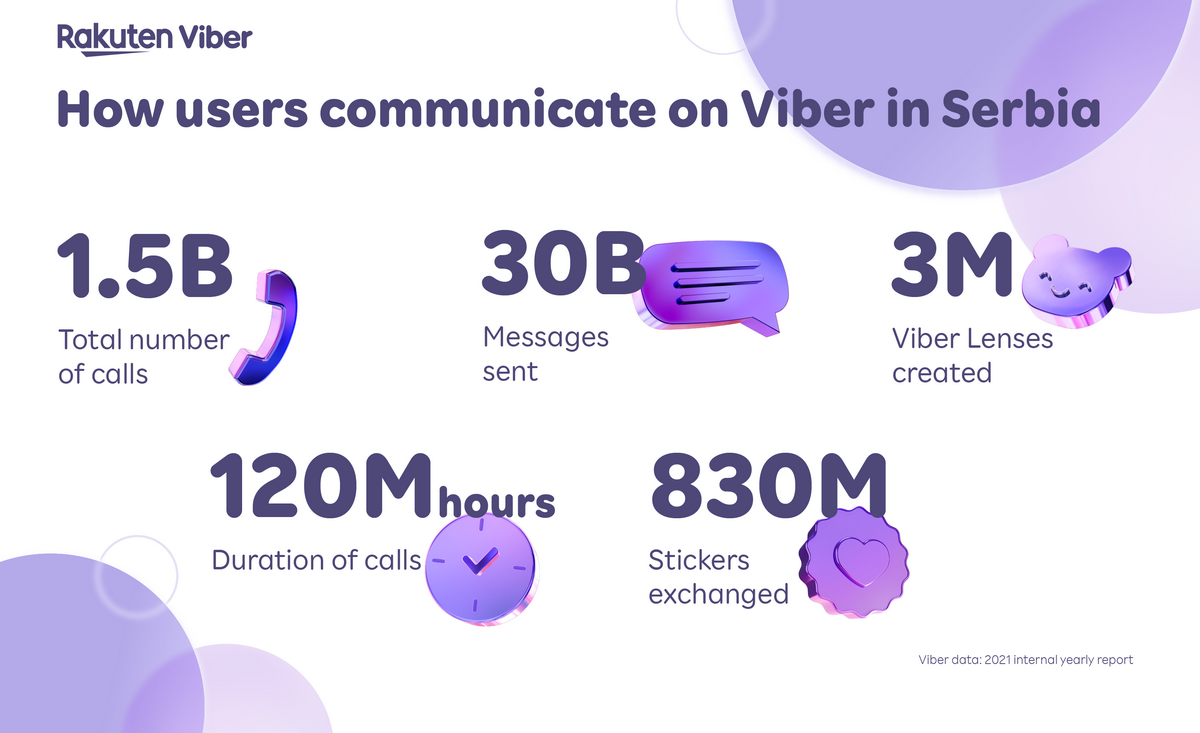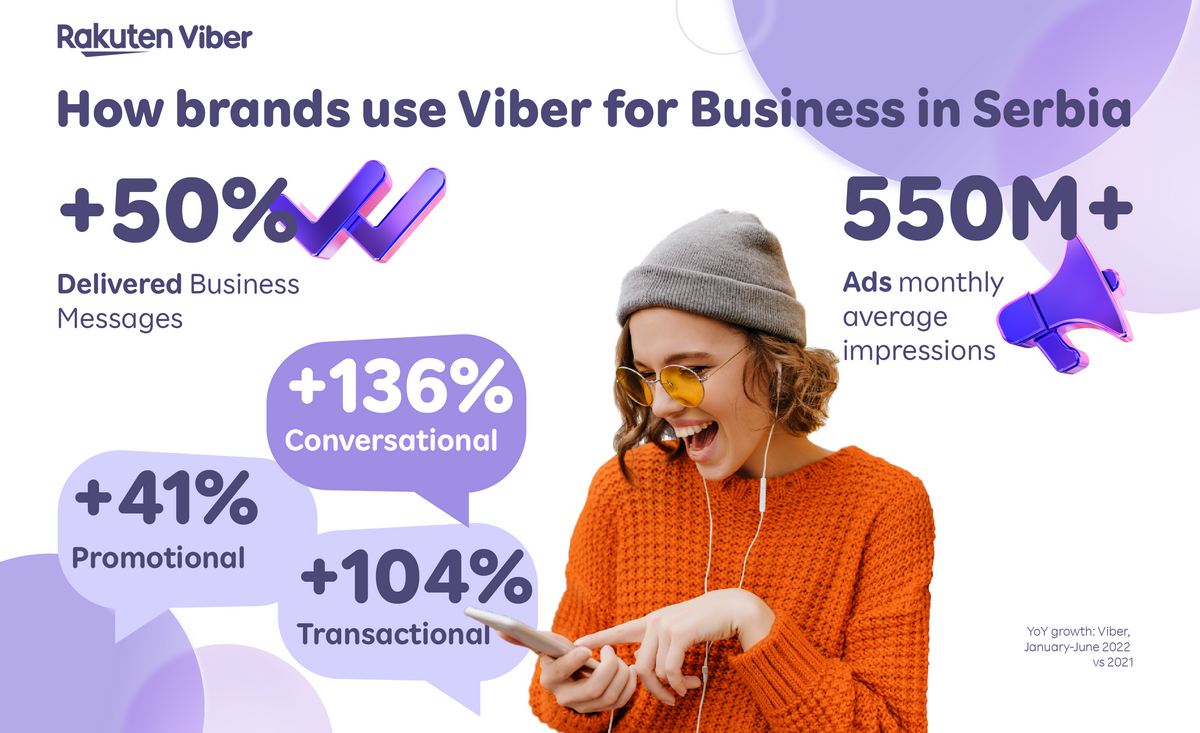People nowadays seek one gateway to many options, and messaging apps, like Viber, are a great platform to integrate multiple services in one place seamlessly

Communication habits change rapidly. We can see more people are seeking real conversation over texting. Here is our insightful interview with Mr Konstantin Kostadinov, senior sales director for CEE and CIS in Rakuten Viber, where he describes all changes in the communication industry from a perspective of a leader in the market.
What are the latest trends in messaging: in the world and in Serbia?
Mobile and messaging app usage is growing strongly worldwide: out of 6,5 hours spent by users on the Internet, more than half of that time is spent on mobile. At the same time, 95.6% of Internet users access chat and messaging apps.
Serbians are also actively using mobile devices and messengers: 78% of mobile phone users in Serbia access the Internet via mobile; 4.9 million Serbs use social media and messaging apps.
Messengers have originated in providing the necessary function: peer-to-peer communication, which makes them indispensable. But if you’re using a messenger daily anyway, it makes sense that people would rather do more with it than just chat with their friends and family – for example, education, payment, purchases, dealing with brands. Today we see that messaging is becoming an integral part of all our daily routines.
Some of us still remember the old dialing phones. Do you think that phone calls are going to history after losing a battle with texting?
It is true that messaging has become more popular over the years, but calls are still a very important part of our lives. All that has changed is that instead of regular phone calls to mobile numbers, we now mostly make calls using messaging apps. I don’t remember how long ago I made a regular phone call, do you?
Our internal data also reveals that users prefer both calls and messages. For example, last year in Serbia we saw a 12% increase in calls on Viber. In general, there were more than 1,5B calls and 30B messages sent in the country.
Out of 6,5 hours spent by users on the Internet, more than half of that time is spent on mobile
However, I wouldn’t say that the days of mobile calling are numbered. A regular phone call can still be very helpful in some emergency situations, especially when there is a poor internet connection.
What about new trends when we talk about customer habits in communication with brands?
Customers expect convenient interactions with businesses: 71% want easy access to communication, and 9 in 10 expect fast responses. Messaging applications, where users already communicate with friends and family, are a viable solution for these needs.
From year to year, we at Viber see a growing trend on brands communicating with customers via the messaging app. As of the first half of the year, we saw a 32% increase in Viber business accounts opened in Serbia, and a 50% increase in Viber business messages delivered.
We also see that consumers today rely more on real conversations rather than the regular one-way messages, contributing to the rise of conversational commerce. As a result, we saw a considerable interest in conversational Viber business messages: in Serbia alone, there was a 136% growth in the first half of this year.
Overall, a fast-paced, chaotic, demanding lifestyle contributes to modern customer demands. People want to streamline their communication and get the most out of interactions with brands.

What would be your TOP-3 recommendations to marketers searching for effective ways to engage the audience?
First of all, go mobile. Whether your business relies on leads from mobile ads or revenues from others advertising on your app or platform, it’s now more important than ever to monitor how those digital ads affect user experience. And with the growth of the mobile marketing space showing no signs of slowing down, paying close attention to best practices in the mobile space will translate to increased profitability for your business.
Check non-intrusive formats. For apps and platforms, most users see ads as an interruption to whatever they were doing on their device, so your goal as an app or website should be to make ads as non-invasive as possible. It’s a delicate balancing act: you need to catch their attention without disrupting the user journey. Whenever possible, make sure your users have the ability to easily close or skip an ad.
The future of advertising is headed toward more innovative formats, including playable ads, immersive and interactive videos, and AR advertising (like recently launched Viber Lenses), all powered by artificial intelligence and machine learning
Lastly, pay attention to the new engaging formats. Native ads (also known as sponsored content) and video ads are the frontrunners among engaging formats. Video in particular is the go-to format for buyers, as it easily catches the user’s attention and drives more engagement. From branded videos that provide non-intrusive engaging content, to rewarded videos that allow users to gain rewards after watching an ad, these formats are more promising than banners. For certain industry niches, such as mobile gaming, some rewarded video ads even allow users to try out a game without having to navigate away from the current app or page.
The future of advertising is headed toward more innovative formats, including playable ads, immersive and interactive videos, and AR advertising (like recently launched Viber Lenses), all powered by artificial intelligence and machine learning.
What is the future of messaging?
The development of the messaging industry is shaped by user demand. Today people no longer want to use apps for different needs separately. Yes, we are all on our smartphones. But did you know that on average app users spend 77% of their time on their top 3 apps? And almost half of their time in one single app.
People nowadays seek one gateway to many options, and messaging apps, like Viber, are a great platform to seamlessly integrate multiple services in one place.
In fact, it is a part of our long-term strategy to become a super app–giving as many services with added value as possible throughout our users’ day and providing brands with more opportunities to interact with their customers in the native environment. We want to let users receive up-to-date information about their courier packages, order taxi, food, have seamless and transparent ways to pay for services, and exchange money with other peers – all directly on Viber.
For example, we recently launched payments on Viber–safe and secure cross-border digital payment solutions. It is yet another step towards our goal of increasing Viber’s utility and making it an absolutely essential app for users.
What is the future of commerce (shopping industry)?
Sell in every channel where your customers are ready to buy
The transformation of the retail industry has had a major impact on the way all businesses operate. It has made it more important than ever for companies to have a strong online presence and to be able to reach their audience through multiple channels and be available at any touchpoint where a customer might be ready to make a purchase.
What’s more, e-commerce is now diversifying into additional ways of shopping: mobile commerce, conversational commerce, and social commerce.
By using modern tools, companies can provide a more convenient and personalized shopping experience for customers, and not only increase sales but help build a close relationship with the audience, too.
C-commerce (Conversational Commerce) is still relatively new, but more and more brands start using it to increase their sales and it is expected to grow rapidly in the coming years. It is a new way of shopping that’s emerging thanks to the rise of messaging apps like Viber. Conversational commerce allows customers to message businesses directly to ask questions, get recommendations, and make purchases without ever having to leave the app. This new way of shopping is convenient, personal, and fast, and it’s changing the way we think about e-commerce in general.
We also see that consumers today rely more on real conversations rather than the regular one-way messages, contributing to the rise of conversational commerce. As a result, we saw a considerable interest in conversational Viber business messages: in Serbia alone, there was a 136% growth in the first half of this year.
